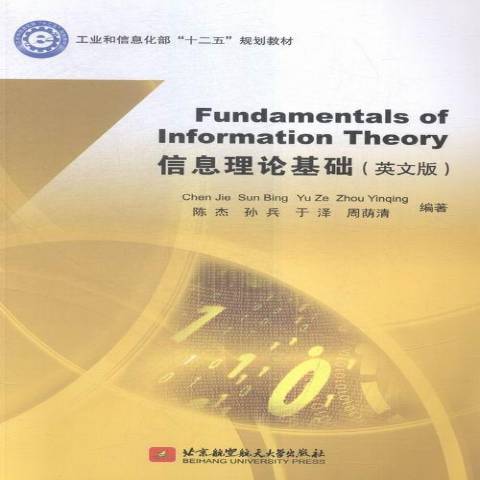《信息理論基礎:英文版》是2016年北京航空航天大學出版社出版的圖書。
基本介紹
- 中文名:信息理論基礎:英文版
- 作者:陳杰,孫兵,於澤
- 出版社:北京航空航天大學出版社
- 出版時間:2016年2月1日
- 開本:16 開
- 裝幀:平裝
- ISBN:9787512419728
內容簡介,圖書目錄,
內容簡介
Thisbooksystematicallyintroducedthefundamentalsofinformationtheory,focusingonthebasicmodelofcommunicationsystems.Itconsistsof11Chapters,includingtwoparts,namely,basicconceptionsofinforGmationtheoryandrelatedapplicationsofinformationtheory.Thefirstpartcontainsstatisticalmeasureofinformation,discretesource,losslesssourcecodinganddatacompression,discretechannelanditscapacity,channelcoding,whilethesecondpartincludesratedistortion,continuoussource,continuouschannelanditscapacity,maximumentropyandspectrumestimationaswellascomputersimulationexperimentsrelevanttoinformationtheory.
Thisbooksummarizedtheexperienceoftheauthorsonteachinginformationcoursein EnglishandChinese,togetherwiththeirunderstandingsfromyearsscientificresearchpractice.Itcanbeusedasteachingmaterialoninform
圖書目錄
Chapter1 Introduction ………………………………………………………………………… 1
1.1 Conceptofinformation ………………………………………………………………… 1
1.2 Historyofinformationtheory ………………………………………………………… 2
1.3 Information,messagesandsignals …………………………………………………… 3
1.4 Communicationsystem model ………………………………………………………… 3
1.5 Informationtheoryapplications ……………………………………………………… 4
1.5.1 Electricalengineering(communicationtheory)………………………………… 4
1.5.2 Computerscience(algorithmiccomplexity) …………………………………… 5
Exercises ……………………………………………………………………………………… 5
Chapter2 StatisticalMeasureofInformation ………………………………………………… 6
2.1 Informationofrandomevents ………………………………………………………… 6
2.1.1 SelfGinformation …………………………………………………………………… 6
2.1.2 ConditionalselfGinformation ……………………………………………………… 6
2.1.3 Mutualinformationofevents …………………………………………………… 7
2.2 Informationofdiscreterandomvariables …………………………………………… 8
2.2.1 Entropyofdiscreterandomvariables …………………………………………… 8
2.2.2 Jointentropy……………………………………………………………………… 11
2.2.3 Conditionalentropy ……………………………………………………………… 11
2.2.4 Mutualinformationofdiscreterandomvariables …………………………… 11
2.3 Relationshipbetweenentropyandmutualinformation …………………………… 11
2.4 Mutualinformationandentropyofcontinuousrandomvariables………………… 12
2.4.1 Mutualinformationofcontinuousrandomvariables ………………………… 12
2.4.2 Entropyofcontinuousrandomvariables ……………………………………… 13
Exercises ……………………………………………………………………………………… 14
Chapter3 DiscreteSourceandItsEntropyRate …………………………………………… 15
3.1 Mathematicalmodelofsource ……………………………………………………… 15
3.1.1 Discretesourceandcontinuoussource ………………………………………… 16
3.1.2 Simplediscretesourceanditsextension ……………………………………… 17
3.1.3 Memorylesssourceandsourcewithmemory ………………………………… 18
3.2 Discretememorylesssource ………………………………………………………… 18
3.2.1 Definition ………………………………………………………………………… 18
3.2.2 Extensionofdiscretesource …………………………………………………… 19
3.3 Discretestationarysource …………………………………………………………… 20
3.3.1 Definition ………………………………………………………………………… 20
3.3.2 Entropyrateofdiscretestationarysource …………………………………… 21
3.4 DiscreteMarkovsource ……………………………………………………………… 24
3.4.1 Markovchain …………………………………………………………………… 24
3.4.2 Transitionprobability …………………………………………………………… 25
3.4.3 Markovsourceanditsentropyrate …………………………………………… 28
Exercises ……………………………………………………………………………………… 31
Chapter4 LosslessSourceCodingandDataCompression ………………………………… 33
4.1 Asymptoticequipartitionpropertyandtypicalsequences ………………………… 33
4.2 Losslesssourcecoding ……………………………………………………………… 34
4.2.1 Encoder …………………………………………………………………………… 34
4.2.2 Blockcode ………………………………………………………………………… 35
4.2.3 Fixedlengthcode………………………………………………………………… 36
4.2.4 Variablelengthcode …………………………………………………………… 42
4.3 Datacompression ……………………………………………………………………… 48
4.3.1 Shannoncoding ………………………………………………………………… 49
4.3.2 Huffmancoding ………………………………………………………………… 50
4.3.3 Fanocoding ……………………………………………………………………… 52
Exercises ……………………………………………………………………………………… 52
Chapter5 DiscreteChannelandItsCapacity ……………………………………………… 54
5.1 Mathematicalmodelofchannel ……………………………………………………… 54
5.2 Discretememorylesschannel ………………………………………………………… 55
5.2.1 Mathematicalmodelofdiscretememorylesschannel ………………………… 55
5.2.2 SimpleDMC ……………………………………………………………………… 56
5.2.3 Extensionofdiscretememorylesschannel …………………………………… 60
5.3 Channelcombination ………………………………………………………………… 65
5.4 Channelcapacity ……………………………………………………………………… 70
5.4.1 Conceptofchannelcapacity …………………………………………………… 70
5.4.2 Channelcapacityofseveralspecialdiscretechannels ………………………… 71
5.4.3 Channelcapacityofsymmetricchannels ……………………………………… 73
5.4.4 ChannelcapacityofextendedDMC …………………………………………… 75
5.4.5 ChannelcapacityofindependentparallelDMC ……………………………… 76
5.4.6 Channelcapacityofthesumchannel…………………………………………… 77
5.4.7 Channelcapacityofgeneraldiscretechannels ………………………………… 78
Exercises ……………………………………………………………………………………… 79
Chapter6 NoisyGchannelCoding ……………………………………………………………… 81
6.1 Probabilityoferror …………………………………………………………………… 81
6.2 Decodingrules ………………………………………………………………………… 83
6.3 Channelcoding ………………………………………………………………………… 84
6.3.1 Simplerepetitioncode …………………………………………………………… 84
6.3.2 Linearcode ……………………………………………………………………… 87
6.4 NoisyGchannelcodingtheorem ……………………………………………………… 91
Exercises ……………………………………………………………………………………… 91
Chapter7 RateDistortion …………………………………………………………………… 93
7.1 Quantization …………………………………………………………………………… 93
7.2 Distortiondefinition…………………………………………………………………… 94
7.2.1 Distortionfunction ……………………………………………………………… 94
7.2.2 MeanGdistortion ………………………………………………………………… 95
7.3 Ratedistortionfunction ……………………………………………………………… 97
7.3.1 Fidelitycriterionforgivenchannel …………………………………………… 97
7.3.2 Definitionofratedistortionfunction…………………………………………… 98
7.3.3 Propertyofratedistortionfunction …………………………………………… 98
7.4 Ratedistortiontheoremandtheconverse ………………………………………… 101
7.5 Thecalculationofratedistortionfunction ………………………………………… 103
Exercises …………………………………………………………………………………… 105
Chapter8 ContinuousSourceandItsEntropyRate ……………………………………… 107
8.1 Continuoussource …………………………………………………………………… 107
8.2 Entropyofcontinuoussource ……………………………………………………… 107
8.3 Maximumentropyofcontinuoussource…………………………………………… 109
8.4 Jointentropy,conditionalentropyandmutualinformationforcontinuous
randomvariables …………………………………………………………………… 109
8.5 Entropyrateofcontinuoussource ………………………………………………… 111
8.6 Ratedistortionforcontinuoussource ……………………………………………… 114
Exercises …………………………………………………………………………………… 117
Chapter9 ContinuousChannelandItsCapacity …………………………………………… 119
9.1 Capacityofcontinuouschannel …………………………………………………… 119
9.1.1 CapacityofdiscreteGtimechannel……………………………………………… 119
9.1.2 CapacityofcontinuousGtimechannel ………………………………………… 120
9.2 TheGaussianchannel ……………………………………………………………… 121
9.3 BandGlimitedchannels ……………………………………………………………… 122
9.4 Codingtheoremforcontinuouschannel …………………………………………… 123
Exercises …………………………………………………………………………………… 124
Chapter10 MaximumEntropyandSpectrumEstimation ………………………………… 125
10.1 Maximumentropyprobabilitydistribution ……………………………………… 125
10.1.1 Maximumentropydistribution ……………………………………………… 125
10.1.2 Examples ……………………………………………………………………… 126
10.2 Maximumentropyspectrumestimation ………………………………………… 127
10.2.1 Burgsmaxentropytheorem ………………………………………………… 127
10.2.2 Maximumentropyspectrumestimation …………………………………… 130
Exercises …………………………………………………………………………………… 137
Chapter11 ExperimentsofInformationTheory …………………………………………… 138
11.1 Measureofinformation …………………………………………………………… 138
11.1.1 Informationcalculator ………………………………………………………… 138
11.1.2 Propertiesofentropy ………………………………………………………… 139
11.2 SimulationofMarkovsource ……………………………………………………… 140
11.3 Performancesimulationforsourcecoding ……………………………………… 141
11.3.1 Shannoncoding ……………………………………………………………… 142
11.3.2 Huffmancoding ……………………………………………………………… 143
11.3.3 Fanocoding …………………………………………………………………… 144
11.4 SimulationofBSC ………………………………………………………………… 144
11.5 Simulationofthecascadechannel ………………………………………………… 145
11.6 Calculationofchannelcapacity …………………………………………………… 148
11.7 Decodingrules ……………………………………………………………………… 149
11.8 Performancedemonstrationofchannelcoding…………………………………… 150
References ……………………………………………………………………………………… 152

